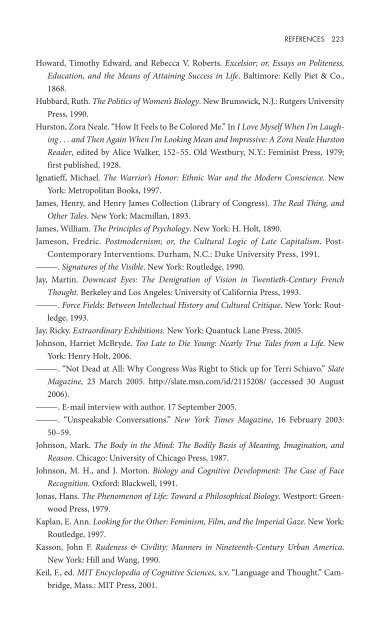Staring how we look sobre la mirada.pdf - artecolonial
Staring how we look sobre la mirada.pdf - artecolonial
Staring how we look sobre la mirada.pdf - artecolonial
Create successful ePaper yourself
Turn your PDF publications into a flip-book with our unique Google optimized e-Paper software.
FACES 107<br />
by allowing a starer to maintain face. Partridge sagely describes an interpersonal<br />
dynamic bet<strong>we</strong>en starer and staree: “They have usually come to help<br />
you, but you may <strong>we</strong>ll find that you have to help them” (Partridge 1990,<br />
17). The active agent here is the staree who saves the face of a starer lost in<br />
a muddle of “shock and concern,” attraction and avoidance, identification<br />
and differentiation.<br />
STAREES AT WORK<br />
Partridge exp<strong>la</strong>ins that the first element in taking control of a staring encounter<br />
is for starees to sense the stare. This preparedness arms a staree<br />
with proper re<strong>la</strong>tional tools to manage expected staring encounters with<br />
great effectiveness. The second element in this process is to decide <strong>how</strong> to<br />
oversee the dynamics of the stare itself when it inevitably arrives. The third<br />
element is manipu<strong>la</strong>ting the eyes of the starer to end, extend, or relocate the<br />
stare. Finally, a staree can and often must engage in conversation to manage<br />
the encounter. Partridge offers: “You will have to keep up the conversation<br />
until you judge it right to help them ask the big question: What happened<br />
to you?” (Partridge 1990, 89). Of course, a staree will have a variety of ready<br />
and fluent ans<strong>we</strong>rs to “this inquisition” — like Macgregor’s intervie<strong>we</strong>e who<br />
said he was in the war—so the encounter can move forward (Partridge 1990,<br />
90). Managed properly by the staree, staring can be an intentional prelude<br />
leading to mutually affirmative face-to-face social interactions.<br />
In addition to maintaining the starer’s face, staring encounters can provide<br />
unusually faced people with an opportunity for self-development. Since<br />
face-work is more exacting for them, they must learn to develop ways of<br />
presenting themselves to others, as Partridge suggests. Rather than causing<br />
narcissism or self pity, having an unorthodox face can take one out of one’s<br />
self because of the responsibility to the other that comes from having to justify<br />
one’s <strong>look</strong>s to the world. Since staring vio<strong>la</strong>tes often unquestioned social<br />
conventions, a productive unruliness can ensue when the predictable structure<br />
of face-work gives way. Partridge posits, for instance, that the starer is<br />
actually frightened by the staree, by the influence a stare has over a starer’s<br />
eyes. To enlist the potency besto<strong>we</strong>d by someone’s fear and convert it into a<br />
form of personal authority inflected by either generosity or command can<br />
en<strong>la</strong>rge the self in ways that are psychologically beneficial and socially effective.<br />
What Partridge calls “successfully bring[ing] some people back from<br />
their recoil” or “turn[ing] the sympathy to constructive uses” requires substantial<br />
psychological acuity and facility (Partridge 1990, 93, 94). Having a<br />
stareable face can shape one in more profoundly positive and productive


